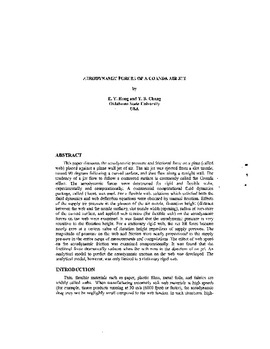| dc.contributor.author | Hong, E. Y. | |
| dc.contributor.author | Chang, Y. B. | |
| dc.contributor.other | International Conference on Web Handling (2003) | |
| dc.date.accessioned | 2019-11-08T21:13:44Z | |
| dc.date.available | 2019-11-08T21:13:44Z | |
| dc.date.issued | 2003-06 | |
| dc.identifier | oksd_icwh_2003_hong | |
| dc.identifier.citation | Hong, E. Y.,& Chang, Y. B. (2003, June). Aerodynamic forces of a Coanda air jet. Paper presented at the Seventh International Conference on Web Handling (IWEB), Stillwater, OK. | |
| dc.identifier.uri | https://hdl.handle.net/11244/321848 | |
| dc.description.abstract | This paper discusses the aerodynamic pressure and frictional force on a plate (called web) placed against a plane wall jet of air. The air jet was ejected from a slot nozzle, turned 90 degrees following a curved surface, and then flew along a straight wall. The tendency of a jet flow to follow a contoured surface is commonly called the Coanda effect. The aerodynamic forces were determined for rigid and flexible webs, experimentally and computationally. A commercial computational fluid dynamics package, called Fluent, was used. For a flexible web, solutions which satisfied both the fluid dynamics and web deflection equations were obtained by manual iteration. Effects of the supply air pressure in the plenum of the air nozzle, floatation height (distance between the web and the nozzle surface), slot nozzle width (opening), radius of curvature of the curved surface, and applied web tension (for flexible web) on the aerodynamic forces on the web were examined. It was found that the aerodynamic pressure is very sensitive to the flotation height. For a stationary rigid web, the net lift force became nearly zero at a certain value of flotation height regardless of supply pressure. The magnitude of pressure on the web and friction were nearly proportional to the supply pressure in the entire range of measurements and computations. The effect of web speed on the aerodynamic friction was examined computationally. It was found that the frictional force dramatically reduces when the web runs in the direction of air jet. An analytical model to predict the aerodynamic traction on the web was developed. The analytical model, however, was only limited to a stationary rigid web. | |
| dc.format | application/pdf | |
| dc.language | en_US | |
| dc.publisher | Oklahoma State University | |
| dc.rights | In the Oklahoma State University Library's institutional repository this paper is made available through the open access principles and the terms of agreement/consent between the author(s) and the publisher. The permission policy on the use, reproduction or distribution of the article falls under fair use for educational, scholarship, and research purposes. Contact Digital Resources and Discovery Services at lib-dls@okstate.edu or 405-744-9161 for further information. | |
| dc.title | Aerodynamic forces of a Coanda air jet | |
| osu.filename | oksd_icwh_2003_hong.pdf | |
| dc.description.department | Mechanical and Aerospace Engineering | |
| dc.type.genre | Conference proceedings | |
| dc.type.material | Text | |
